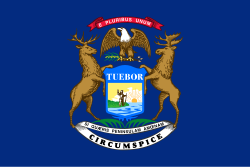| 8th Michigan Infantry Regiment | |
|---|---|
 Michigan state flag | |
| Active | September 23, 1861, to June 30, 1865 |
| Country | United States |
| Allegiance | Union |
| Branch | Infantry |
| Engagements | Port Royal Expedition James Island, S.C. Battle of Secessionville Second Battle of Bull Run Battle of Chantilly Battle of South Mountain Battle of Antietam Battle of Fredericksburg Siege of Vicksburg Knoxville Campaign Battle of the Wilderness Battle of Spotsylvania Court House Battle of Cold Harbor Siege of Petersburg Battle of the Crater |
The 8th Michigan Infantry Regiment was an infantry regiment that served in the Union Army during the American Civil War.